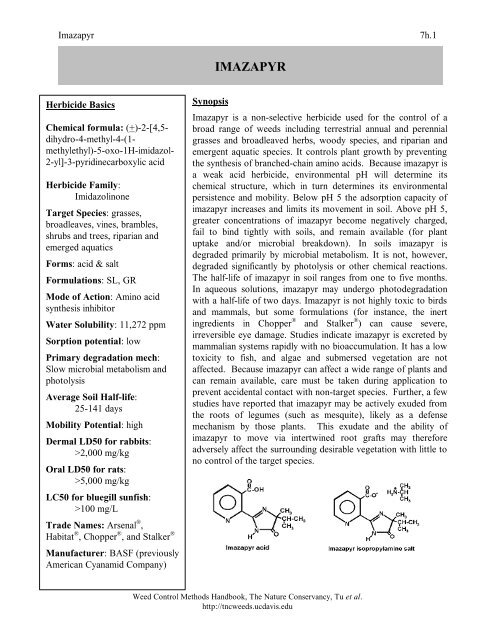Weed Control Methods Handbook: Tools ... - Invasive.org
Weed Control Methods Handbook: Tools ... - Invasive.org
Weed Control Methods Handbook: Tools ... - Invasive.org
You also want an ePaper? Increase the reach of your titles
YUMPU automatically turns print PDFs into web optimized ePapers that Google loves.
Imazapyr 7h.1<br />
IMAZAPYR<br />
Herbicide Basics<br />
Chemical formula: (+)-2-[4,5-<br />
dihydro-4-methyl-4-(1-<br />
methylethyl)-5-oxo-1H-imidazol-<br />
2-yl]-3-pyridinecarboxylic acid<br />
Herbicide Family:<br />
Imidazolinone<br />
Target Species: grasses,<br />
broadleaves, vines, brambles,<br />
shrubs and trees, riparian and<br />
emerged aquatics<br />
Forms: acid & salt<br />
Formulations: SL, GR<br />
Mode of Action: Amino acid<br />
synthesis inhibitor<br />
Water Solubility: 11,272 ppm<br />
Sorption potential: low<br />
Primary degradation mech:<br />
Slow microbial metabolism and<br />
photolysis<br />
Average Soil Half-life:<br />
25-141 days<br />
Mobility Potential: high<br />
Dermal LD50 for rabbits:<br />
>2,000 mg/kg<br />
Oral LD50 for rats:<br />
>5,000 mg/kg<br />
LC50 for bluegill sunfish:<br />
>100 mg/L<br />
Trade Names: Arsenal ® ,<br />
Habitat ® , Chopper ® , and Stalker ®<br />
Manufacturer: BASF (previously<br />
American Cyanamid Company)<br />
Synopsis<br />
Imazapyr is a non-selective herbicide used for the control of a<br />
broad range of weeds including terrestrial annual and perennial<br />
grasses and broadleaved herbs, woody species, and riparian and<br />
emergent aquatic species. It controls plant growth by preventing<br />
the synthesis of branched-chain amino acids. Because imazapyr is<br />
a weak acid herbicide, environmental pH will determine its<br />
chemical structure, which in turn determines its environmental<br />
persistence and mobility. Below pH 5 the adsorption capacity of<br />
imazapyr increases and limits its movement in soil. Above pH 5,<br />
greater concentrations of imazapyr become negatively charged,<br />
fail to bind tightly with soils, and remain available (for plant<br />
uptake and/or microbial breakdown). In soils imazapyr is<br />
degraded primarily by microbial metabolism. It is not, however,<br />
degraded significantly by photolysis or other chemical reactions.<br />
The half-life of imazapyr in soil ranges from one to five months.<br />
In aqueous solutions, imazapyr may undergo photodegradation<br />
with a half-life of two days. Imazapyr is not highly toxic to birds<br />
and mammals, but some formulations (for instance, the inert<br />
ingredients in Chopper ® and Stalker ® ) can cause severe,<br />
irreversible eye damage. Studies indicate imazapyr is excreted by<br />
mammalian systems rapidly with no bioaccumulation. It has a low<br />
toxicity to fish, and algae and submersed vegetation are not<br />
affected. Because imazapyr can affect a wide range of plants and<br />
can remain available, care must be taken during application to<br />
prevent accidental contact with non-target species. Further, a few<br />
studies have reported that imazapyr may be actively exuded from<br />
the roots of legumes (such as mesquite), likely as a defense<br />
mechanism by those plants. This exudate and the ability of<br />
imazapyr to move via intertwined root grafts may therefore<br />
adversely affect the surrounding desirable vegetation with little to<br />
no control of the target species.<br />
<strong>Weed</strong> <strong>Control</strong> <strong>Methods</strong> <strong>Handbook</strong>, The Nature Conservancy, Tu et al.<br />
http://tncweeds.ucdavis.edu
















